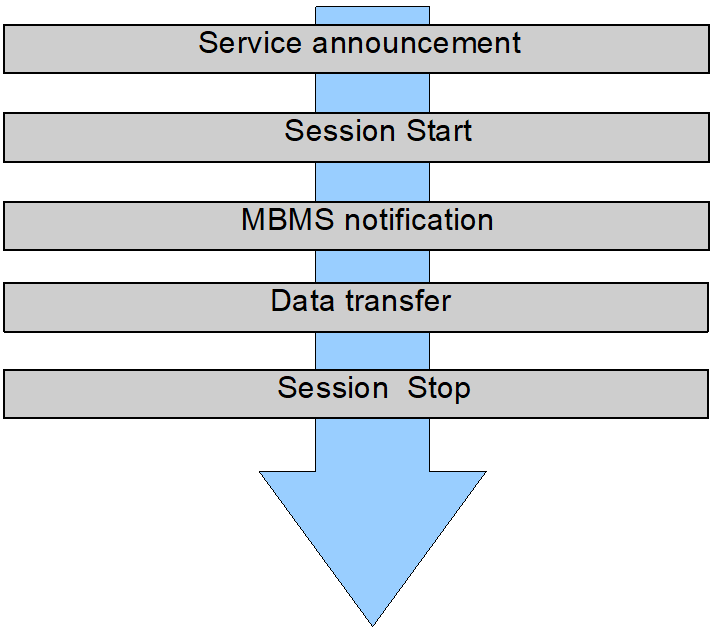Content for TS 23.246 Word version: 17.0.0
4.4.3 BROADCAST MODE
4.4.3.1 Service announcement
4.4.3.1a UE local service activation
4.4.3.2 Session Start
4.4.3.3 MBMS notification
4.4.3.4 Data transfer
4.4.3.5 Session Stop
4.4.3.6 Session Update
4.4.4 Broadcast Mode timeline
...
...
4.4.3 BROADCAST MODE p. 16
An example for the phases of MBMS broadcast service provision is described in the Figure below:

The sequence of phases may repeat, e.g. depending on the need to transfer data. It is also possible that the service announcement and MBMS notification phase may run in parallel with other phases, in order to inform UEs which have not yet received the related service.

4.4.3.1 Service announcement p. 18
Informs UEs about forthcoming MBMS user services. Also see clause 4.4.1.2 on Multicast mode.
4.4.3.1a UE local service activation p. 18
The MBMS user service part in the UE initiates reception of the MBMS bearer service to receive an MBMS user service. In case one MBMS user service is carried by more than one MBMS bearer service, the UE may need to initiate the reception of multiple relevant MBMS bearer services to receive the MBMS user service (see clause 8.12).
4.4.3.2 Session Start p. 18
Session Start is the point at which the BM-SC is ready to send data. This can be identified with the start of a "Broadcast session" as defined in TS 22.146. Session Start is the trigger for bearer resource establishment for MBMS data transfer. If an MBMS user service is carried by more than one MBMS bearer service, a Session Start message is sent for each MBMS bearer service. In that case the UE may need to initiate the reception of multiple relevant MBMS bearer services to receive the MBMS user service.
4.4.3.3 MBMS notification p. 18
Informs the UEs about forthcoming (and potentially about ongoing) MBMS broadcast data transfer.
4.4.3.4 Data transfer p. 18
It is the phase when MBMS data are transferred to the UEs.
4.4.3.5 Session Stop p. 19
It is the point at which the MBMS user service determines that there will be no more data to send for some period of time - this period being long enough to justify removal of bearer resources associated with the service. At Session Stop, the bearer resources are released.
4.4.3.6 Session Update |R7| p. 19
Session Update is used to update specific parameters of an ongoing MBMS Broadcast session. Parameters which can be updated are MBMS Service Area, and/or the List of SGSNs/MMEs (only from BM-SC to GGSN or MBMS GW). A Session Update received in one node, results in a Session Update being sent to downstream nodes, to inform of the changed MBMS Service Area. When a Session Update is received in the GGSN or MBMS GW including the List of SGSN/MME parameter, it results in a Session Start being sent to new downstream nodes, and in a Session Stop being sent to downstream nodes that have been removed from the list.
In order to support the update of the priority of a broadcast data flow of a group communication service as specified in TS 23.468, the QoS(ARP parameter only) of an MBMS Broadcast service session may be modified by the Session Update procedure.
4.4.4 Broadcast Mode timeline p. 19
4.4.4.1 Period between Service Announcement and Session Start p. 19
Same as for Multicast mode.
4.4.4.2 Period between Session Start and First Data Arrival p. 19
Same as for Multicast mode.
4.4.4.3 Period between Session Start and Session Stop p. 19
Same as for Multicast mode.